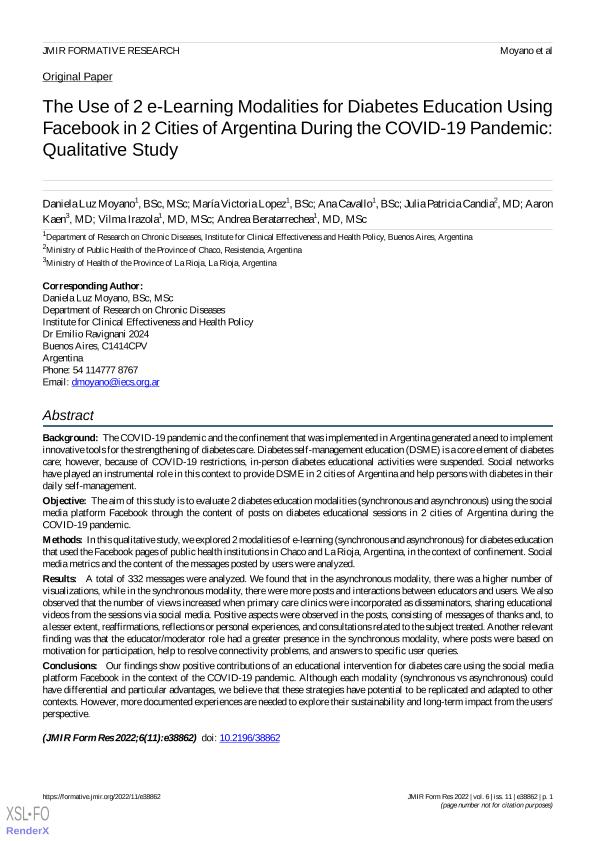Mostrar el registro sencillo del ítem
dc.contributor.author
Moyano, Daniela Luz

dc.contributor.author
López, Maria Victoria

dc.contributor.author
Cavallo, Ana
dc.contributor.author
Candia, Julia Patricia
dc.contributor.author
Kaen, Aaron Arnaldo

dc.contributor.author
Irazola, Vilma

dc.contributor.author
Beratarrechea, Andrea Gabriela

dc.date.available
2024-02-05T13:22:29Z
dc.date.issued
2022-11
dc.identifier.citation
Moyano, Daniela Luz; López, Maria Victoria; Cavallo, Ana; Candia, Julia Patricia; Kaen, Aaron Arnaldo; et al.; The Use of 2 e-Learning Modalities for Diabetes Education Using Facebook in 2 Cities of Argentina During the COVID-19 Pandemic: Qualitative Study; JMIR Publications Inc.; JMIR Formative Research; 6; 11; 11-2022; 1-11
dc.identifier.uri
http://hdl.handle.net/11336/225778
dc.description.abstract
Background: The COVID-19 pandemic and the confinement that was implemented in Argentina generated a need to implement innovative tools for the strengthening of diabetes care. Diabetes self-management education (DSME) is a core element of diabetes care; however, because of COVID-19 restrictions, in-person diabetes educational activities were suspended. Social networks have played an instrumental role in this context to provide DSME in 2 cities of Argentina and help persons with diabetes in their daily self-management. Objective: The aim of this study is to evaluate 2 diabetes education modalities (synchronous and asynchronous) using the social media platform Facebook through the content of posts on diabetes educational sessions in 2 cities of Argentina during the COVID-19 pandemic. Methods: In this qualitative study, we explored 2 modalities of e-learning (synchronous and asynchronous) for diabetes education that used the Facebook pages of public health institutions in Chaco and La Rioja, Argentina, in the context of confinement. Social media metrics and the content of the messages posted by users were analyzed. Results: A total of 332 messages were analyzed. We found that in the asynchronous modality, there was a higher number of visualizations, while in the synchronous modality, there were more posts and interactions between educators and users. We also observed that the number of views increased when primary care clinics were incorporated as disseminators, sharing educational videos from the sessions via social media. Positive aspects were observed in the posts, consisting of messages of thanks and, to a lesser extent, reaffirmations, reflections or personal experiences, and consultations related to the subject treated. Another relevant finding was that the educator/moderator role had a greater presence in the synchronous modality, where posts were based on motivation for participation, help to resolve connectivity problems, and answers to specific user queries. Conclusions: Our findings show positive contributions of an educational intervention for diabetes care using the social media platform Facebook in the context of the COVID-19 pandemic. Although each modality (synchronous vs asynchronous) could have differential and particular advantages, we believe that these strategies have potential to be replicated and adapted to other contexts. However, more documented experiences are needed to explore their sustainability and long-term impact from the users' perspective.
dc.format
application/pdf
dc.language.iso
eng
dc.publisher
JMIR Publications Inc.
dc.rights
info:eu-repo/semantics/openAccess
dc.rights.uri
https://creativecommons.org/licenses/by-nc-sa/2.5/ar/
dc.subject
COVID-19
dc.subject
diabetes mellitus
dc.subject
eHealth literacy
dc.subject
online learning
dc.subject
public health
dc.subject
qualitative research
dc.subject
social media
dc.subject
teaching and learning settings
dc.subject.classification
Políticas y Servicios de Salud

dc.subject.classification
Ciencias de la Salud

dc.subject.classification
CIENCIAS MÉDICAS Y DE LA SALUD

dc.title
The Use of 2 e-Learning Modalities for Diabetes Education Using Facebook in 2 Cities of Argentina During the COVID-19 Pandemic: Qualitative Study
dc.type
info:eu-repo/semantics/article
dc.type
info:ar-repo/semantics/artículo
dc.type
info:eu-repo/semantics/publishedVersion
dc.date.updated
2024-01-18T10:37:10Z
dc.identifier.eissn
2561-326X
dc.journal.volume
6
dc.journal.number
11
dc.journal.pagination
1-11
dc.journal.pais
Canadá

dc.description.fil
Fil: Moyano, Daniela Luz. Instituto de Efectividad Clínica y Sanitaria; Argentina
dc.description.fil
Fil: López, Maria Victoria. Instituto de Efectividad Clínica y Sanitaria; Argentina. Consejo Nacional de Investigaciones Científicas y Técnicas; Argentina
dc.description.fil
Fil: Cavallo, Ana. Instituto de Efectividad Clínica y Sanitaria; Argentina
dc.description.fil
Fil: Candia, Julia Patricia. Ministerio de Salud Publica ; Gobierno de la Provincia de Chaco;
dc.description.fil
Fil: Kaen, Aaron Arnaldo. Ministerio de Salud; Argentina
dc.description.fil
Fil: Irazola, Vilma. Instituto de Efectividad Clínica y Sanitaria; Argentina. Consejo Nacional de Investigaciones Científicas y Técnicas; Argentina
dc.description.fil
Fil: Beratarrechea, Andrea Gabriela. Instituto de Efectividad Clínica y Sanitaria; Argentina. Consejo Nacional de Investigaciones Científicas y Técnicas; Argentina
dc.journal.title
JMIR Formative Research
dc.relation.alternativeid
info:eu-repo/semantics/altIdentifier/url/https://formative.jmir.org/2022/11/e38862/
Archivos asociados
